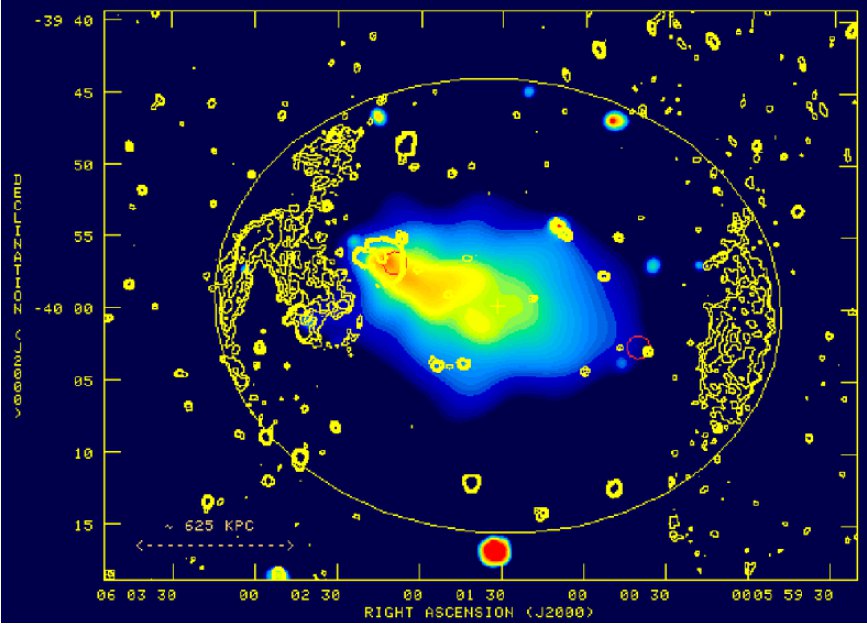

Clusters of galaxies are the largest gravitationally bound structures in the Universe. Their baryonic composition is dominated by hot gas that is in quasi-hydrostatic equilibrium within the dark matter dominated gravitational potential well of the cluster. The hot gas is visible through spatially extended thermal X-ray emission, and it has been studied extensively both for assessing its physical properties and also as a tracer of the large-scale structure of the Universe.

|

|
| Fig. 1: Mapping of the intracluster gas and radio emission in Abell 3376 a, b | Fig. 2: The 6.9-7.0 keV part of a simulated 100 ks calorimeter spectrum for IXO ( top panel) and Astro-H ( bottom panel) for a supra-thermal electron distribution. Solid line: best-fit model to a pure Maxwellian plasma, with temperature 16.99 keV. Note the excess emission of satellite lines in the data, in particular, the Fe XXV j-line. Enhanced equivalent widths of satellite lines are good indicators of non-thermal electrons. The satellite line in the simulated spectrum is clearly stronger than that predicted by the thermal model with a Maxwellian electron distribution. This exercise illustrates, that in order to observationally reveal non-Maxwellian tails in the electron distributions, we will need high-resolution spectra obtained by future satellites with a large effective area. |
Clusters of galaxies are not isolated entities in the Universe: they are connected through a filamentary cosmic web. Theoretical predictions indicate the way this web is evolving. In the early Universe most of the gas in the web was relatively cool (T ~ 104 K) and visible through numerous absorption lines, designated as the so-called Ly-alpha forest. In the present Universe, however, about half of all the baryons are predicted to be in a warm phase (105 - 107 K), the Warm-Hot Intergalactic Medium (WHIM), with temperatures intermediate between the hot clusters and the cool absorbing gas causing the Ly_alpha forest.To study the budget of barionic matter and energy in the observed cosmic web, one have to study also the nonthermal components like magnetic fields and non-thermal energetic particles [1].
Observational cosmology boosted by the WMAP and Plank measurements of the cosmic microwave background anisotropy, high-redshift supernovae distribution, light element abundances and impressive progress in X-ray studies of clusters of galaxies is now entered the stage of the precision science. Clusters of galaxies being currently the largest gravitationally bounded objects are used to study cosmic structure evolution and to constrain the basic parameters of the concordance cosmological model. In the case of clusters the precision cosmology approach requires an account of all the physical components contributing to the energy density with accuracy better than 10%. Magnetic fields, energetic particles and non-thermal matter motions in clusters of galaxies contribute to the intracluster matter (ICM) pressure at least at a level above a few percent and the actual contribution could be substantially higher.
We studied the nonthermal phenomena in clusters of galaxies in the context of the hierarchical model of cosmic structure formation by accretion and merging of the dark matter (DM) substructures [2]. Accretion and merging processes produce large-scale gas shocks [3]. The plasma shocks are expected to be collisionless. In the course of cluster aggregation, the shocks, being the main gas-heating agent also generate turbulent magnetic fields and accelerate energetic particles via collisionless multi-fluid plasma relaxation processes . The intracluster gas heating and entropy production rate by a collisionless shock may differ significantly from that in a single-fluid collisional shock [4]. Simple scaling relations for postshock ion temperature and entropy as functions of shock velocity in strong collisionless multi-fluid shocks are presented in [5]. We show that the multi-fluid nature of the collisionless shocks results in high gas compression, reduced entropy production and modified galaxy velocity dispersion –Temperature, Mass–Temperature and X-ray luminosity –Temperature scalings. The scaling indexes estimated for a simple model of a strong accretion multi-fluid shock are generally consistent with observations. Soft X-ray and ultraviolet photons dominate the emission of strong accretion shock precursors that appear as large-scale filaments. Magnetic fields, turbulence and energetic particles constitute the nonthermal components contributing into the pressure balance, energy transport and emission of clusters. Nonthermal emission of energetic particles could be a test to constrain the cluster properties [6, 7, 8, 9, 10]